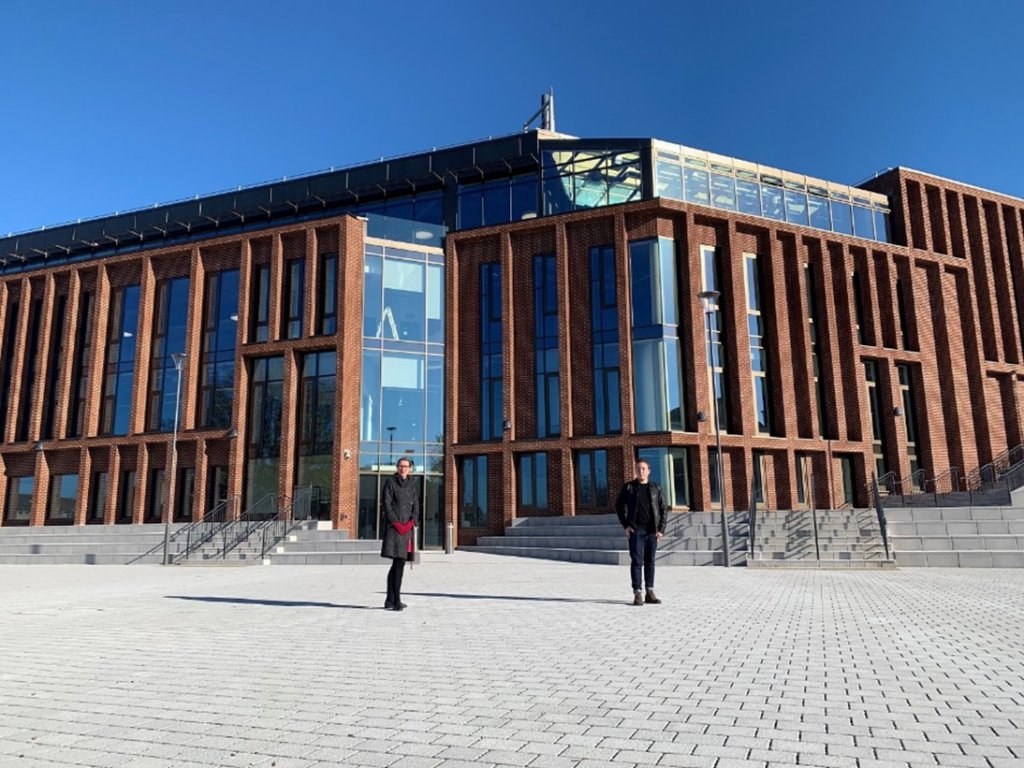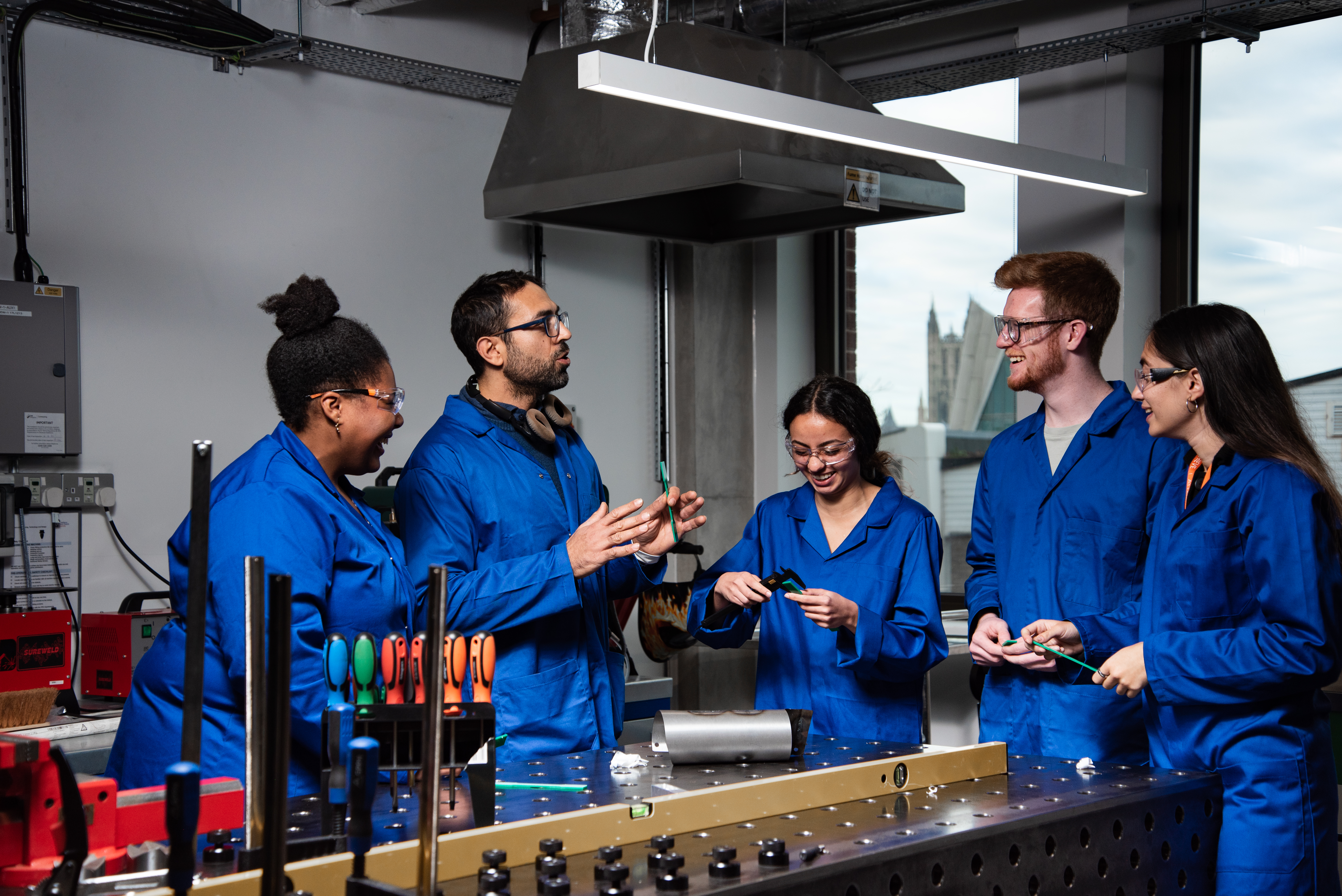Canterbury Christ Church University is nestled in the heart of one of the oldest cities in England: Kent. Its rich tapestry of history is still illustrated in the fabric of the city today. Picture Roman city walls, medieval homes, Georgian and Victorian shops, and the modern Verena Holmes Building at Canterbury Christ Church University.
Canterbury Christ Church University received a 14.8 million pounds investment to develop the Kent and Medway Engineering, Design Growth Enterprise (EDGE) Hub. This has led to the development of the new Science, Technology, Engineering and Medicine (STEM) education and research facilities. Kent and Medway EDGE Hub’s vision is to support the development of an inclusive, diverse pipeline of industry-ready graduates that can contribute to regional, national and international enterprises.
The new School of Engineering, Technology and Design at Canterbury Christ Church University has been designed to be truly inclusive in terms of facilities and resources, curriculum content and learning facilitation, diverse engineering academic staff (39% female and 57% Black/Asian), and industrial learning opportunities.
The School’s new facilities are in the new Verena Holmes Building. Verena Holmes was a local trailblazer. She was the first woman to join the Institute of Mechanical Engineers (IMechE ) in 1924 as well as the first woman to have a full-time career as a professional mechanical engineer, innovator and engineering entrepreneur, running her own engineering firm set up in 1946 that employed only women.
In keeping with Verena Holmes’s spirit of creating inclusive and entrepreneurial engineering graduates, the School has adopted the Conceive, Design, Implement and Operate (CDIO) engineering education practice developed by the Massachusetts Institute of Technology (MIT). To ensure students get commercial practice, the CDIO projects are typically sourced from industry. Students from foundation year to the final year of their degree can work in groups solving real industry problems.

Learning comes to life with the School of Engineering, Technology and Design’s industrial opportunities. Source: Canterbury Christ Church University
Foundation year students had the opportunity to work with international company Barton Marine company on a CDIO project to research and develop more sustainable sailing cleat (a T-shaped piece of metal or wood on a boat or ship, to which ropes are attached). The client brief was to investigate if sailing cleat made from recycled plastic waste is of high quality, fit for purpose and reduces the carbon footprint of the product.
“I was very impressed with how quickly foundation students understood the problem and offered practical ‘real world’ solutions. They produced a practical solution enabling us to improve the performance of our product,” says the Operations Manager of Barton Marine Equipment Ltd.
AMC Ltd is a local enterprise that specialises in CNC machining and manufacturing of locks for trade vehicle manufacturers. They approached CCCU with a CDIO project for the first year students (who are local and international) to identify methods to improve unique design features and manufacturability of the locks that would appeal to their client TVL and Ford Motor Company. The academics won the support of Engineers in Business Fellowship to offer a 3,000 pounds prize to the best project solution determined by AMC Ltd and academics as well.
“The students have done a tremendous job in providing various mechanical solutions, one of which we will consider taking forward into production and we congratulate the winning team on their Engineers in Business Fellowship (EIBF) prize,” says Chris Hambrook, Director of AMC.
The second year students this year have worked with Cactus Graphics, a Dover-based printing and graphic design company. The company is moving to a new facility and wanted help with the design and layout of the new shop floor to support lean and Six Sigma manufacturing techniques. The students successfully modelled the different solutions that supported the reduction of wastage as well as improved inventory flow.
“Working with the Canterbury Christ Church University team is always a professional pleasure. The students were invested and committed to the business solution we asked them to find. They all presented their projects professionally for our decision making,” says Richard Archer, Commercial Director of Cactus Graphics.
“We had the exciting opportunity to work alongside Cactus Graphics which taught us both presentation skills and improved our CAD ability. Although it can be a challenge, the rewards will be worth it. I cannot wait to impact the future of engineering in a good way,” shares Lucy Pushman, a second year BEng Biomedical Engineering student.
What’s more, students have had the opportunity to apply for summer placement/internship opportunities. One such opportunity, was undertaken by Natasha Vaccaro, a third year BEng Chemical Engineering student, this was made available and funded by the national council BBSRC via Algae-UK-UCL-BIERG to support industrial collaboration with a company producing omega-3 fatty acids for the multimillion-pound nutrition market.
Omega-3 production from microalgae is a more environmentally friendly and sustainable solution than eating fish. However, measuring omega-3 production on thriving microalgae is challenging. Successful production is manually assessed at the end of experiments — this scouting project proposed viable real-time monitoring techniques for measuring omega-3 production inside living microalgae. The student identified that Raman Spectroscopy and Nuclear Magnetic Resonance is a potential solution to the problem.
Another summer student internship funded by the University was under the supervision of Dr. Xin Yi Ong and Dr. Najah Battikh to research and develop methods to capture polymer microfibres from aqueous bodies via flocculation, i.e. capture microplastics in a process. The aim of the project is to capture microplastics in domestic water systems. The student project results indicate great potential for commercial practice and sustainable solution for society, development of industry-academic-student collaboration.
Internship opportunities have also been created with industry. These have been open to all students at any academic level. One such opportunity was with Aptus Outdoor Ltd, a company that deals with retail fishing tackle. They support students who had completed their first year to research and develop sustainable solution for their fishing weights.
“During my internship with Aptus, I was able to apply my project skills, the knowledge I had learnt from my mathematics class, and material modules to real-world industry problems. I was supported by my tutors during the project and had access to university facilities to support my research!” says Jesse Fuller, a second year MEng Product Design Engineering student.

Support is always available for engineering students here. Source: Canterbury Christ Church University
Canterbury Christ Church University offers a variety of engineering programmes, some of which include a foundation year: Mechanical Engineering, Product Design Engineering, Biomedical Engineering, General Engineering, and Software Engineering
“I’ve received the best experience from our engineering department at Canterbury Christ Church University. Our facilities and friendly staff make learning new techniques and researching subject areas as expansive and interesting as they can be. They explore our potential to their limit and beyond!” says Charlotte Brown, final year BEng Software Engineering student.
Leonette Dias, a final year BEng Year 3 Chemical Engineering student, agrees. “Studying chemical engineering has been challenging and the staff here at Canterbury Christ Church University have been extremely helpful at guiding me all the way through, allowing me to overcome challenges,” she says. “We have had projects sourced from industry and with every one of them I conquer, I feel more confident that I can be an engineer and solve real-life problems. Having a majority female-led staff has been inspirational to me, and highlighted to me that the world is changing, and more female engineers and leadership is needed at the forefront of this change. I want to be a part of this and also encourage you to join.”
For Naomi Williams, a second year BEng Biomedical Engineering student, her programme has armed her with the ability to understand and analyse the sustainability of everything we do (along with what an engineer could do to help). “Knowing that I’m being equipped to someday use this skill to help the world is not only edifying but inspiring,” she says.
Follow Canterbury Christ Church University on Facebook, Twitter, YouTube and Instagram.










